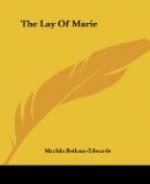Vincent de Beauvois, a contemporary of Mary, speaks likewise of this Romulus and his fables[25]; and lastly, Fabricius informs us that this author has very much imitated Phaedrus, and often preserved even his expressions.[26] But, after all, it is uncertain who is this Romulus, thus invested with the title of emperor; whether the last Roman emperor of that name, who is likewise called Augustulus or Romulus the grammarian. I should rather attribute them to some monk of the 11th or 12th century. The rites of the Roman Catholic worship are several times alluded to, and entire passages of the Vulgate very frequently inserted.
It is, however, enough to know that in the time of Mary, there did actually exist a collection of fables called Aesopian, and published under the name of Romulus; that this author, whether real or imaginary, had very much imitated Phaedrus; that these Latin fables had been translated into English; that, without doubt, those of some other unknown writers were added to them; and, finally, that from this latter version Mary made her translation into French verse.
In a MS. of the fables of Mary, it is said this English version was the work of King Mires.[27] The Harleian MS. No. 978, makes the translation to have been King Alurez. The MS. cited by Pasquier, calls him King Auvert.[28] The MS. in the Royal Library, 15 A. VII. says the translation was made by the order of King Affrus; and, lastly, the Harleian MS. No. 4333, makes it the work of King Henry.
With respect to King Alurez or Auvert, every one who has examined our ancient writers of romance, during the 12th and 13th centuries, must know that the name of Alfred was thus disfigured by them. Thus, two kings of England, Alfred and Henry, have a claim to that honour. But whence is it that the historian of Alfred, Asser, as well as William of Malmesbury, have mentioned the different translations of this prince, without having noticed that of Aesop?[29] Is it credible that an Anglo-Saxon version of the ninth century would have been intelligible to Mary, who had only learned the English of the thirteenth? Had not the lapse of time, and the descents of the Danes and Normans in the eleventh century, contributed, in the first place, to alter the Anglo-Saxon? and afterwards, during the twelfth, the rest of the people from the northern and western provinces of France, having become dependent upon England, did not they, likewise, by their commerce, and residence in that country, introduce a considerable change into its language? The names of Seneschal, Justiciar, Viscount, Provost, Bailiff, Vassal, &c. which occur in these fables, both in the Latin text and French translation by Mary, ought naturally to have been found in the English version. Now these several terms were all, according to Madox, introduced by the Normans;[30] and the morals to these fables, which make frequent allusion to the feudal system, prove more and more, that this English translation must have been posterior to the time of Alfred.




